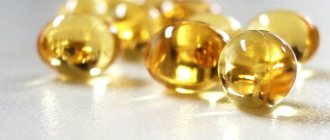Vitamins are chemical compounds of organic origin that are found in food products and perform specific functions in the human body. Vitamins are an integral part of nutrition, as they are needed for the proper functioning of the body. Some vitamins are included in enzymes necessary for biochemical reactions that constantly occur in the human body, or are themselves converted into enzymes, others act as catalysts in these reactions, and others can act as precursors of hormones and hormones themselves.
As of 2012, 13 chemicals are recognized as vitamins and two more are being considered for inclusion in the vitamin family. Vitamins are not the most stable compounds and lose their activity under the influence of atmospheric oxygen, moisture, acidic environment, sunlight, elevated temperature and other factors. This must be taken into account when preparing food - vitamins are practically not preserved during cooking, frying and other types of food processing.
Interestingly, there are substances that have effects opposite to those of vitamins. They are called antivitamins. Antivitamins are used to study the physiological role of vitamins in the human body.
Water-soluble and fat-soluble vitamins
Vitamins are classified into two main groups - fat-soluble and water-soluble. Fat-soluble vitamins are vitamins A, D, E, K, water-soluble vitamins are vitamin C, P, B vitamins. Fat-soluble vitamins are better absorbed when taken together with fats, while water-soluble vitamins do not require fats to work. Fat-soluble vitamins can be deposited in the body, accumulating in adipose tissue and in the liver. Water-soluble vitamins do not create a reserve, and in case of excess they are simply excreted.
In the early 1940s, Academician Palladin created a chemically water-soluble analogue of fat-soluble vitamin K. The substance was called vikasol. Later, water-soluble versions of the remaining fat-soluble vitamins were obtained.
Most vitamins are not synthesized in the body and therefore must come from outside. With a lack of vitamins in the diet, numerous metabolic disorders occur, which affects the health and well-being of a person. Everyone knows that a lack of vitamins should not be allowed; at the same time, their excess has a harmful effect on the body. Vitamin A is on the agenda today.
How to deal with the problem?
According to doctors, it is necessary to periodically examine the child. If symptoms appear, you should not wait for them to go away on their own. Doctors can not only understand the cause of the disease, but also prescribe comprehensive treatment in a timely manner and give nutritional recommendations. The bulk of all vitamins enters the body, only a small part of them is synthesized independently.
To prevent children from having symptoms, you need to follow simple steps:
- Nutrition. Often parents seat their children at the common table too early, which leads to an imbalance in the child’s body. When products for a child are selected taking into account age, vitamin deficiency can be completely avoided. Therefore, every day the child should eat porridge, vegetables and fruits, greens, dairy products.
- Walks in the open air. Especially during the warm period, you need to walk with your baby as much as possible, starting almost from birth. When this happens, there will definitely be no problems with vitamin D. But in winter, the child can receive it additionally in the form of vitamins. But excess vitamin D has its own deviations, so only a doctor can calculate the dose and make a prescription.
- If there is little vitamin C, then taking Rutin and ascorbic acid helps. It’s good if the baby eats greens all year round, rosehip decoction also helps. It is good to give it in the form of tea or simply instead of water.
- Meat and dairy products will help supplement the body with vitamin B. But sometimes they are purchased from pharmacies and taken in courses.
- The above vitamins are quickly replenished, but the most complex one is A. It will take from 3 to 6 months to fill the child’s body with them. In this case, everything happens strictly, this is a diet in food, as well as some vitamins intramuscularly.
It turns out that in order to prevent any deviations, you will have to carefully monitor the rhythm of the child’s life and his nutrition. The baby needs to spend more time outdoors and get physical activity. At the same time, the mother constantly needs to monitor the child’s condition and, if there is any sign, consult a doctor. Only a specialist will be able to understand the problem and prescribe restoration.
Properties of vitamin A
Vitamin A can be formed in the body from precursor substances supplied by food. The required daily dose of vitamin A is 300-900 mcg for adults and 600-3000 mcg for children. Its chemical name is retinol. The discovery of vitamin A dates back to 1913 - scientists discovered that it is found in butter and the yolk of chicken eggs. In 1931, its structure was described, and 15 years later, vitamin A was recreated chemically.
Vitamin A can exist in different forms. Thus, vitamin A includes retinoids, retinal, retinoic acid. Vitamin A is involved in many important processes in the human body. Retinal is a component of rhodopsin, the main visual pigment. Retinoic acid stimulates growth and development. Retinol itself is found in cell membranes and provides an antioxidant effect.
All types of vitamin A are found in animal products, but retinol itself is unstable, so it is combined with other substances. Plants contain vitamin A precursors - carotenoids. The body converts carotenoids into vitamin A, but some animals, such as cats, do not, meaning they cannot get vitamin A from plants.
In humans, most vitamin A is stored in the liver and less (10%) in the kidneys, adrenal glands and fat. It is used in the synthesis of sex hormones, enzymes, interferon, immunoglobulin A, rhodopsin. Vitamin E supports the activity of vitamin A. In the treatment of eye disease, popularly known as “night blindness,” it is used together with vitamins B2 and B3. In other diseases, vitamin D is a companion.
Daily requirements
The daily requirement for vitamin A varies depending on gender, age, and level of physical activity:
- infants up to one year - 400-500 mcg (1333-1667 IU);
- children under 14 years of age, depending on age and weight – 400-700 mcg (1333-2333 IU);
- men 14 years and older – 1000 mcg (3300 IU);
- women 14 years and older – 800 mcg (2667 IU);
- pregnant women – 200-800 mcg (667-2667 IU);
- nursing mothers – 400-1200 mcg (1333-4000 IU);
- elderly people - 800 mcg (2667 IU).
The need for vitamin A increases with heavy physical activity, diseases of the liver, intestines, stomach, stress, and diabetes. In addition, the daily intake of the vitamin needs to be increased for those who live in hot climates or consume excess amounts of protein, which is often observed among adherents of sports nutrition. Vitamin A is also needed in large quantities during periods of active growth and development.
What foods contain vitamin A?
Vitamin A is found in plant and animal foods. It is found in significant quantities in the liver of marine fish and mammals. People can get vitamin A in the form of carotenoids, but only a small proportion of carotenoids can be converted into vitamin A. Carotenoids are found in carrots (although amounts vary among varieties), red bell peppers, green onions, lettuce, pumpkin, tomatoes, spinach, cabbage broccoli, parsley, soybeans and peas, and from fruits - in apples, grapes, apricots, rose hips, peaches, watermelon and melon, cherries and sea buckthorn. Among animal products, there is a lot of vitamin A in fish oil and liver, butter, cheese, milk, cottage cheese, and also, as you already know, in the yolk of eggs. Since vitamin A is a fat-soluble vitamin, it is better to take it with fat, for example, in the form of a salad of grated carrots with sour cream or boiled eggs with mayonnaise.
Causes of hypovitaminosis
The causes of vitamin A deficiency may be associated with external exposure to unfavorable factors, including a deficiency of this substance and its precursors in food. Moreover, this can happen not only due to a forced diet depletion or as a result of exotic diets. Vitamin A is fat-soluble, and if you exclude foods containing fats from your diet, the absorption of retinoids and carotenoids will decrease. Improper storage of foods can also lead to a decrease in the vitamin A content in them. Infants may suffer from vitamin deficiency if they are weaned early.
Another group of causes of vitamin A deficiency are internal. Deficiency can occur as a result of impaired lipid absorption, bile formation, smoking and alcoholism. A rare congenital disorder, hypercarotenemia, in which the intestinal enzyme responsible for the synthesis of vitamin A from provitamins is absent, can also lead to a lack of vitamin A.
Vitamin A deficiency: immunity and more
With a lack of vitamin A, damage to the epithelium occurs - cells, in particular, lining the mucous membrane of internal organs, vision decreases, and washing of the cornea with tear fluid is impaired. In addition, weakened immunity and growth retardation are noted. Experts estimate that in developing countries, vitamin A deficiency deprives approximately 250-500 thousand children of vision every year.
Vitamin A deficiency can be primary or secondary. Primary occurs when nutrition does not supply the required dose of vitamin A, secondary - when fat absorption and bile formation are constantly impaired, as well as with chronic oxidation of vitamin A, which occurs with smoking and alcohol abuse. Vitamin A deficiency increases with a lack of zinc, which is important for those countries where there is insufficient nutrition and malnutrition.
With hypovitaminosis A, “night blindness” occurs, or, scientifically, hemeralopia; the epithelium throughout the body suffers - from the skin and eyes to the intestines and bronchi. In the intestines, vitamin A deficiency can lead to the formation of ulcers, in the bronchi - to frequent bronchitis. As for the eyes, in addition to hemeralopia, the sloughing epithelium clogs the lacrimal canals, which interferes with the washing of the cornea with tears and can lead to xerophthalmia. Subsequently, the cornea softens, an ulcerative defect and a thorn form on it. Secondary infection accelerates corneal damage. In children, a lack of vitamin A leads to slow growth and development. With hemeralopia, the ability to see and navigate in space at dusk is impaired. If the disease is not congenital, vitamin A is the treatment.
Consequences of hypo- and vitamin deficiency
Symptoms of hypo- and avitaminosis are difficult to diagnose, as they are not always accompanied by characteristic signs. The clinical picture of vitamin deficiencies is a rather rare phenomenon in the modern world; hypovitaminosis and polyhypovitaminosis (lack of several vitamins) are more common.
Night blindness (hemeralopia) is a known disease associated with a lack of vitamin A. Retinol is necessary for the formation of rhodopsin, a specific substance responsible for light perception. The symptoms of the disease are quite characteristic. A person sees poorly in the evening and at night, at dusk. During the day, vision does not deteriorate. The disease is more often observed in women after 50 years of age, which is associated with menopausal changes in the body. Hemeralopia develops with a lack of vitamin A gradually, over several years. The course of the disease is aggravated by a lack of vitamins PP and riboflavin.
Hypo- or avitaminosis A is manifested not only by hemeralopia. With a deficiency of retinol, the conjunctiva suffers, its dryness (xerosis) and dry eye syndrome develop. The skin becomes rough, hyperkeratosis develops, a symptom of “fish scales”.
The history of the discovery of vitamins is closely related to the disease beriberi. It was this disease, which is alimentary polyneuritis, that became the first on the list of doctors, the development of which was associated with a lack of vitamins, namely thiamine (vitamin B1). A lack of vitamin leads to an increase in the concentration of pyruvic acid in the body, which is accompanied by nervous symptoms.
Vitamin deficiency (hypovitaminosis B1) is accompanied by nausea, weakness, and loss of appetite. Irritability, fatigue, decreased concentration and memory gradually increase.
Ariboflavinosis (vitaminosis B2) is a disease associated with a lack of vitamin B2 (riboflavin). The vitamin is part of enzyme systems and its deficiency causes cellular anoxia (insufficient oxygen supply). The clinical picture of the disease has characteristic signs: damage to the skin and oral mucosa. Stomatitis, conjunctivitis, hypochromic anemia, and neurotic disorders develop. Vitamin B2 deficiency occurs against the background of a lack of other B vitamins.
Pellagra - develops as a result of prolonged vitamin deficiency B3 and B5. The development of the disease is facilitated by a lack of the amino acid tryptophan and B vitamins. A deficiency of biologically active substances leads to dermatitis, indigestion and pellagros polyneuritis. A severe course of the disease is observed during famine, military operations, and natural disasters. Alcoholism, cirrhosis of the liver and other pathologies in which the absorption of nutrients in the intestine is impaired also leads to hypovitaminosis RR.
Hypovitaminosis of pantothenic acid is accompanied by the following clinical signs:
- loss of appetite, indigestion;
- neurological symptoms;
- dryness, flaking of the skin.
Hypo- and avitaminosis B6 (beri-vitaminosis of pyridoxine) is observed with insufficient intake from food and impaired metabolism of the vitamin in the body. Vitamin deficiency leads to dermatological problems, stomatitis, conjunctivitis, swelling in the corners of the lips, and disruption of the gastrointestinal tract.
B12-folate deficiency anemia (vitaminosis B12, Addison-Birmer disease) is closely associated with deficiency and metabolic disorders of not only vitamin B12, but also folic acid. These substances have a hemostimulating effect and are involved in the synthesis of red blood cells. Deficiency of vitamin B12 and folic acid leads to megaloblastic anemia. In this case, damage is observed not only to the hematopoietic system, but also to the digestive and nervous systems. Anemia more often develops in women after 40 years of age, in some ethnic groups, and in vegetarians.
For a long time people have suffered from a disease called scurvy. At the beginning of the 20th century, it became clear that the cause of the disease was a deficiency of vitamin C. Ascorbic acid is not synthesized by the body itself and must be supplied in sufficient quantities with food. Sailors, residents of the north, and the poor often died from this disease.
Scurvy develops with prolonged fasting and indigestion. The course of the disease is long-term and debilitating. Symptoms of the disease: loss of strength, exhaustion, hemorrhage, periodontal disease, impaired cardiac and pulmonary activity.
A disease such as rickets occurs due to a lack of vitamin D. The pathology develops in childhood. With a deficiency of the vitamin, the absorption processes of calcium and phosphorus are disrupted, mineral deposition into bone tissue does not occur, and the reabsorption of calcium from the kidneys is disrupted. The disease is characterized by neurological and autonomic changes, then osteomalacia and skeletal deformation develop.
In addition to rickets in children, hypovitaminosis D leads to the development of osteoporosis in adulthood. This insidious disease does not reveal itself for a long time. Osteoporosis affects mostly women during menopause due to hormonal changes in the body. During this difficult period of life, it is especially important to monitor the intake of vitamin D in sufficient quantities. Under its influence, the bones receive a sufficient amount of minerals and remain strong.
The cause of fertility disorders in the body of men and women can be hypo- and vitamin E deficiency (tocopherol deficiency). Vitamin deficiency can occur when following diets, fasting, menopause, or taking contraceptive medications. Symptoms of vitamin E deficiency:
- impaired fertility, pathology of reproductive function;
- skin pigmentation;
- neurological disorders;
- calf muscle cramps, intermittent claudication;
- decreased immunity.
Hypovitaminosis E leads to impaired sexual development in adolescence, decreased fertility in both sexes, loss of fertilizing ability of sperm in men, and pregnancy pathology in women.
One of the main causes of hemorrhagic syndrome is vitamin deficiency K. The disease is characterized by hemorrhages, bleeding and is associated with a pathological disorder of blood coagulation processes. The disease may be accompanied by megaloblastic anemia. In severe vitamin deficiency, blood is observed in the urine and feces, and gastric bleeding. The disease requires urgent medical intervention.
Spring vitamin deficiency on the hands can occur due to several reasons
Many people mistake spring vitamin deficiency for an allergy and begin to get rid of it with antihistamines, which only worsens the situation. The main problem is that modern people are more self-medicating and rarely turn to specialists. A person can make a diagnosis for himself, buy a drug at the pharmacy, which in the end not only will not help, but will also provoke a complication.
Before treating vitamin deficiency, you need to find out the cause of its occurrence, and there may be several of them. The most common is poor nutrition, as well as eating food with large amounts of carcinogens and concentrates. Bad habits are another source of progression of spring vitamin deficiency. Smoking and excessive alcohol consumption have a bad effect not only on the appearance of the hands, but also on the entire body.
Doctors also identify among the reasons that can provoke spring vitamin deficiency - these are diseases of the stomach and intestines, disruption of the endocrine system, and exhaustion of the body by hard work. Therefore, before starting treatment, it is worth undergoing a general diagnosis. This is especially recommended for pregnant women who suffer from vitamin deficiency.
Manifestations of vitamin deficiency
Vitamin deficiency is manifested by various symptoms of vitamin deficiency. If even one of them is present, urgent measures must be taken to identify the cause and treat:
- peeling of the skin;
- headache, insomnia;
- splitting of nails;
- dandruff, increased hair loss;
- lack of appetite;
- dry mouth;
- constant weakness;
- mood swings;
- muscle and bone pain;
- increased skin pigmentation, bruises;
- poor vision in the evenings;
- bleeding gums, aching pain.
Manifestation of vitamin deficiency in children:
- at risk are premature babies (the gastrointestinal tract is insufficiently formed) or if the child after six months is exclusively breastfed without additional complementary foods, and the main reason is a monotonous diet with a lack of vitamins;
- The most common signs of vitamin deficiency in children are disturbances in appetite and sleep, rashes or peeling of the skin, inflammation of the mucous membranes, frequent colds, abnormal stool, deformation of bones, perversion of taste (attempts to eat chalk, etc.).
Signs of excess vitamins in a child (hypervitaminosis)
Often a child experiences such a phenomenon as hypervitaminosis - an excess of certain vitamins in the body.
The cause of hypervitaminosis is uncontrolled intake of vitamin preparations, excessive intake of food rich in vitamins and minerals, individual intolerance to vitamins and increased sensitivity to them. Only a doctor can determine the cause by conducting a series of diagnostic and laboratory studies.
With excess vitamin A:
- the child’s behavior changes—signs of lethargy, weakness, and reluctance to move appear;
- hydrocephalus develops, characterized by the accumulation of fluid in the head;
- the child’s sleep is disturbed, increased irritability appears, he cries for no reason;
- the functioning of the stomach and intestines is disrupted, manifested by decreased appetite, upset stool, nausea, and periodic vomiting;
- a rash appears on the skin;
- nails become brittle;
- pain appears in the joints;
- the functioning of the liver and kidneys is disrupted;
- elevated cholesterol levels are detected in the blood.
Hypervitaminosis B in a child is characterized by:
- noticeable redness of the skin;
- periodic dizziness and headache;
- disorder of the intestinal and stomach functions, manifested by abdominal pain, diarrhea or constipation, nausea;
- skin tingling sensation and hypersensitivity;
- sleep disturbance;
- cramps in the calf muscles.
Hypervitaminosis D is caused by:
- changes in the child’s behavior - the child becomes lethargic, inactive and capricious, easily loses temper;
- thirst and increased water consumption;
- increased urine output;
- loss of appetite, vomiting and nausea;
- noticeable weight loss;
- increased body temperature;
- convulsive manifestations of muscles.
Excess vitamin E in the body manifests itself:
- headaches and muscle pain;
- increased fatigue, weakness, tiredness;
- disorders of the stomach and intestines;
- depletion of bone tissue, which subsequently leads to frequent fractures;
- double vision.
Diagnosis of vitamin deficiency
Diagnosis of vitamin deficiency includes a primary analysis of the clinical picture of the disease and a number of laboratory and instrumental examination techniques, which are prescribed by the pediatrician after examining the child. The most informative tests include x-ray examination and biochemical blood test.
If the disease is present, X-rays show:
- blurriness and indistinctness of areas of calcification of bone structures;
- the appearance of a gap between the end sections of the bone (epiphyses) and the central fragment (diaphysis);
- shadows from growths on the surface of bone formations.
An equally important study is a biochemical blood test. With rickets, the level of phosphorus and calcium is reduced, and the level of a specific liver enzyme, alkaline phosphatase, is increased. Using these indicators, one can judge the severity of the disease, as well as determine the characteristics of its development over time. Additionally, the child undergoes a urine and blood test for vitamin D. If its level is low during the test, then these results also confirm the presence of rickets.
Treatment
For treatment, complex medications or those containing certain vitamins are prescribed.
It is not recommended to purchase products for the treatment of vitamin deficiency without consulting a doctor. Only a specialist can make an accurate diagnosis and choose the appropriate vitamins.
In addition to medications, you need to eat suitable foods. A healthy diet that contains nutrient-rich foods will speed up your recovery. Unlike vitamin complexes, there is no risk of overdose.
Vitamin content in products:
Prevention
Effective disease prevention consists of several factors:
- Healthy eating;
- Daily regime;
- Physical activity;
- Sunlight.
Form a routine from a very early age for your baby. The correct regime will help its harmonious, healthy development. Energy consumption will occur taking into account the allotted time for sleep.
Gymnastics, light jogging, and passion for sports are beneficial for a growing body. Try to walk more, sign up your child for swimming, football, dancing or other sports clubs.
The benefits of ultraviolet light have already been mentioned. Sunlight is not only a good way to increase vitamin D and eliminate symptoms of vitamin deficiency, but also an excellent boost of good mood for the whole family.
It is worth changing the lifestyle, nutrition and physical development of the child, how this will best affect the household. Healthy baby – happy parents!











